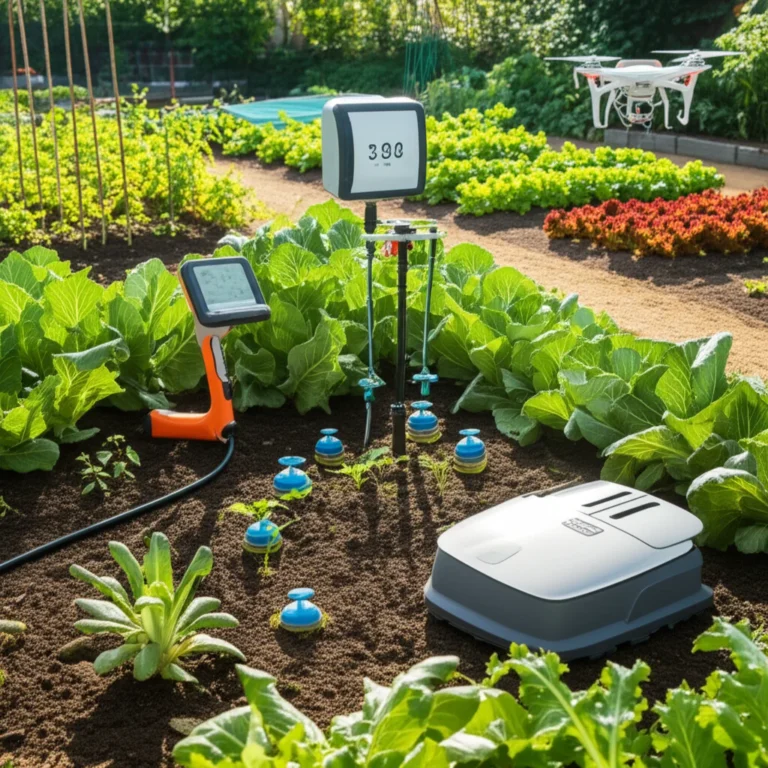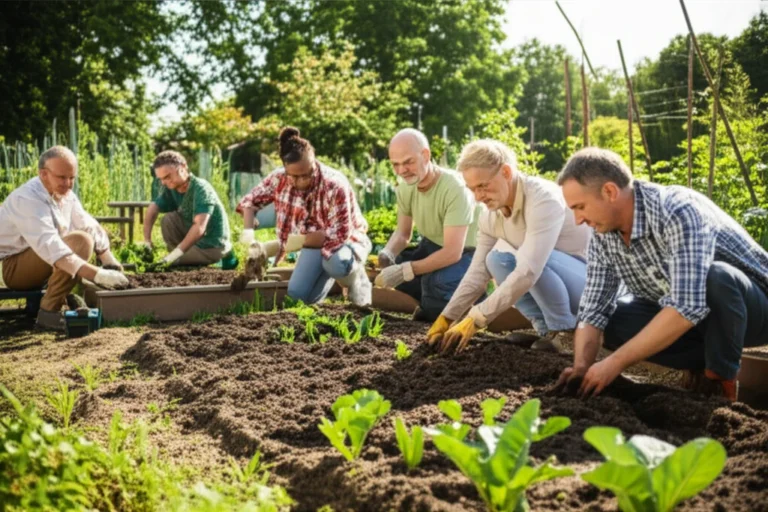Support our educational content for free when you purchase through links on our site. Learn more

Did you know that community gardens aren’t just about fresh veggies and friendly faces? They’re also about smart financial planning! Running a successful community garden requires more than just green thumbs; it demands a savvy understanding of diverse funding models. This comprehensive guide explores ten (and more!) innovative ways to ensure your community garden thrives financially, from membership fees and grants to product sales and creative partnerships. We’ll equip you with the knowledge and strategies to cultivate a financially sustainable and vibrant community hub. Ready to discover how to make your garden bloom financially? Let’s dive in!
Key Takeaways
- Diversify your income streams: Don’t rely on a single funding source. Explore memberships, plot rentals, workshops, product sales, grants, and sponsorships.
- Build strong community relationships: Engage local businesses for sponsorships and partnerships. A thriving community fosters financial sustainability.
- Track expenses meticulously: Know where your money goes to make informed decisions.
- Promote your garden actively: Use social media, local newspapers, and community events to attract members and sponsors.
- Embrace volunteer power: Volunteers reduce labor costs and build community spirit.
👉 Shop essential gardening supplies:
- Gardening Tools: Amazon | Home Depot
- Seeds & Seedlings: Amazon | Burpee
- Compost & Soil: Amazon | FoxFarm
Table of Contents
The Evolution of Community Gardens: A Financial Sustainability Journey
Funding Models for Thriving Community Gardens
- Membership Fees and Dues: Cultivating Community Support
- Grants and Fundraising: Harvesting Financial Resources
- Sponsorships and Corporate Partnerships: Growing Collaborative Opportunities
- Product Sales and Revenue Streams: From Seed to Sale
- Educational Workshops and Classes: Sharing Expertise and Generating Income
- Volunteer Programs and Community Engagement: Fostering Collaboration and Support
- Government Funding and Subsidies: Tending to Public-Private Partnerships
- Crowdfunding and Online Platforms: Reaching a Wider Audience
- Events and Festivals: Celebrating Community and Generating Revenue
- Farm-to-Table Dinners and Culinary Experiences: A Taste of Community
Creative Funding Strategies for Community Gardens
Overcoming Financial Challenges in Community Gardening
Key Takeaways: Ensuring the Long-Term Financial Health of Your Community Garden
Quick Tips and Facts
Let’s get our hands dirty with some quick wins for your community garden’s financial health! 🌱
- Diversify your income streams: Don’t rely on a single source of funding. Explore memberships, plot rentals, workshops, product sales, and grants.
- Build strong community relationships: Engage local businesses for sponsorships and partnerships. A happy community is a financially sustainable community!
- Track your expenses meticulously: Know where your money is going to make informed decisions and secure more funding.
- Promote your garden actively: Use social media, local newspapers, and community events to raise awareness and attract members and sponsors.
- Embrace volunteer power: Volunteers are invaluable for reducing labor costs and fostering community spirit. Think of them as your unpaid, enthusiastic interns!
The Evolution of Community Gardens: A Financial Sustainability Journey
Community gardens have come a long way! Initially, they were primarily focused on providing food and fostering community spirit. However, as the need for financial sustainability became apparent, innovative business models emerged. We’ve seen a shift from purely relying on donations and grants to incorporating diverse income streams. This evolution is crucial for ensuring the long-term success of these vital community hubs. Learn more about the history of community gardens and their impact here.
Funding Models for Thriving Community Gardens
Here’s the lowdown on how to keep those green thumbs turning a profit (or at least breaking even!). Remember, a diverse approach is key – don’t put all your seeds in one basket!
-
Membership Fees and Dues: Cultivating Community Support
- Offer different membership tiers with varying benefits (e.g., plot access, workshop discounts, priority event registration).
- Make it clear what members are paying for and the value they receive.
- Consider a sliding scale for fees to make it accessible to all income levels.
- Example: Our Community Gardening™ program offers a tiered system with benefits like access to our expert workshops and exclusive events.
-
Grants and Fundraising: Harvesting Financial Resources
- Research local, regional, and national grant opportunities. Many organizations support community gardening initiatives.
- Organize fundraising events (e.g., plant sales, potlucks, community festivals).
- Utilize crowdfunding platforms (e.g., GoFundMe, Kickstarter) to reach a wider audience.
- Example: We successfully secured a grant from the National Gardening Association to fund our new composting program.
-
Sponsorships and Corporate Partnerships: Growing Collaborative Opportunities
- Approach local businesses for sponsorships in exchange for advertising or product placement.
- Partner with businesses to offer workshops or events.
- Explore opportunities for cross-promotion and mutual benefit.
- Example: We partnered with Home Depot to secure tools and materials for our garden projects.
-
Product Sales and Revenue Streams: From Seed to Sale
- Sell excess produce at farmers’ markets, community events, or through a Community Supported Agriculture (CSA) program.
- Offer value-added products like jams, pickles, or baked goods made from garden produce.
- Sell seeds, seedlings, or other gardening supplies.
- Example: Our CSA program allows members to receive a weekly share of fresh, seasonal produce.
-
Educational Workshops and Classes: Sharing Expertise and Generating Income
- Offer workshops on various gardening topics (e.g., composting, organic gardening, seed starting).
- Partner with local experts to enhance the quality of your workshops.
- Charge a fee for participation, offering discounts for members.
- Example: Our popular composting workshop teaches participants how to create nutrient-rich soil for their gardens.
-
Volunteer Programs and Community Engagement: Fostering Collaboration and Support
- Recruit volunteers to assist with various tasks (e.g., planting, weeding, harvesting).
- Offer volunteer appreciation events to show gratitude for their contributions.
- Create a welcoming and inclusive environment to attract and retain volunteers.
- Example: Our volunteer program provides valuable support and fosters a strong sense of community.
-
Government Funding and Subsidies: Tending to Public-Private Partnerships
- Explore local, state, and federal government programs that support community gardens.
- Partner with government agencies to leverage resources and expertise.
- Advocate for policies that support community gardening initiatives.
- Example: We successfully applied for a grant from the USDA to support our urban farming project.
-
Crowdfunding and Online Platforms: Reaching a Wider Audience
- Utilize crowdfunding platforms to raise funds for specific projects or initiatives.
- Create a compelling campaign that highlights the impact of your garden.
- Engage your community through social media to promote your crowdfunding campaign.
- Example: We used Kickstarter to successfully fund our new greenhouse project.
-
Events and Festivals: Celebrating Community and Generating Revenue
- Organize community events (e.g., harvest festivals, plant swaps, cooking demonstrations).
- Charge admission fees or sell food and drinks at your events.
- Partner with local businesses to sponsor your events.
- Example: Our annual harvest festival is a popular community event that generates significant revenue.
-
Farm-to-Table Dinners and Culinary Experiences: A Taste of Community
- Host farm-to-table dinners featuring produce from your garden.
- Partner with local chefs to create unique culinary experiences.
- Charge a fee for participation, offering discounts for members.
- Example: Our farm-to-table dinners are a unique way to showcase the bounty of our garden and engage the community.
Creative Funding Strategies for Community Gardens
Thinking outside the box is key! Here are some unique ideas to boost your garden’s finances:
- Corporate sponsorships: Partner with local businesses for mutually beneficial collaborations. Imagine a local brewery sponsoring your annual pumpkin carving contest! 🎃
- Art installations: Host art exhibitions or workshops featuring garden-inspired themes.
- Community workshops: Offer classes on gardening, cooking, or other related skills.
- Subscription boxes: Deliver fresh produce or gardening supplies directly to members’ doorsteps.
- Photography and videography: Capture the beauty of your garden and sell prints or videos.
Overcoming Financial Challenges in Community Gardening
Even the most successful gardens face hurdles. Here’s how to navigate them:
- Budgeting and financial planning: Create a realistic budget and track your expenses carefully.
- Grant writing: Master the art of grant writing to secure funding for your projects.
- Fundraising: Develop a comprehensive fundraising strategy that includes diverse approaches.
- Volunteer management: Effectively manage your volunteers to maximize their contributions.
- Community engagement: Build strong relationships with your community to foster support and participation.
Key Takeaways: Ensuring the Long-Term Financial Health of Your Community Garden
Remember: Financial sustainability is vital for the long-term success of your community garden. By diversifying your income streams, building strong community relationships, and managing your resources effectively, you can ensure that your garden thrives for years to come. And don’t forget to have fun! Gardening should be enjoyable, too! 😊
Conclusion
Creating a financially sustainable community garden requires a multifaceted approach. It’s not just about digging in the dirt; it’s about digging into creative funding strategies and building strong community partnerships. By embracing diverse income streams, actively engaging your community, and managing your resources effectively, you can ensure that your garden flourishes for years to come, providing fresh produce, fostering community spirit, and enriching lives. Remember, the journey is as rewarding as the harvest! 🥕
Recommended Links
For further reading on community gardening and financial management, check out these books:
- “The Community Garden Book: How to Start and Maintain a Successful Community Garden” Amazon
👉 Shop the brands mentioned:
- GoFundMe: GoFundMe
- Kickstarter: Kickstarter
- Home Depot: Home Depot
- National Gardening Association: National Gardening Association
- USDA: USDA
FAQ
How can community gardens generate revenue through plot rentals and membership fees?
Plot rentals and membership fees are fundamental income streams for community gardens. By offering various plot sizes and membership tiers with different benefits, gardens can cater to diverse needs and budgets. Clear communication about the value proposition of each tier is crucial. For example, a higher-tier membership might include access to workshops, priority plot selection, or exclusive events. This tiered approach allows gardens to maximize revenue while ensuring accessibility for all income levels.
What are the best practices for setting plot rental and membership fees?
Conduct thorough market research to understand prevailing rates in your area. Consider factors like plot size, location, amenities, and community demographics. A sliding scale for fees can enhance accessibility and inclusivity. Regularly review and adjust fees to reflect changing costs and community needs.
What are the most effective ways for community gardens to secure grants and funding from local organizations?
Securing grants requires a well-crafted proposal that clearly articulates the garden’s mission, goals, and impact. Research potential funding sources thoroughly, focusing on organizations aligned with your garden’s objectives. Develop strong relationships with grant-making organizations and attend relevant networking events. A compelling narrative that highlights the community benefits of the garden is essential for securing funding.
How can I improve my grant proposal writing skills?
Seek guidance from experienced grant writers or attend workshops on grant writing. Use clear and concise language, focusing on the impact of your project. Tailor your proposal to the specific requirements and priorities of each funding organization.
Can community gardens sustain themselves through sales of fresh produce, value-added products, and educational programs?
Absolutely! Selling fresh produce at farmers’ markets or through a CSA program can generate significant revenue. Value-added products like jams, pickles, or baked goods can increase profit margins and attract a wider customer base. Educational programs, such as workshops on gardening techniques or cooking classes, can provide additional income streams while fostering community engagement. A well-balanced approach that combines these revenue streams can contribute significantly to a garden’s financial sustainability.
What are some creative ways to market and sell value-added products?
Partner with local businesses to sell your products in their stores. Organize pop-up shops or participate in local craft fairs. Use social media and email marketing to promote your products. Develop a strong brand identity that reflects the uniqueness of your garden and its products.
What role can sponsorships, partnerships, and crowdfunding play in supporting the financial sustainability of community gardens?
Sponsorships and partnerships with local businesses can provide crucial financial support and enhance the garden’s visibility within the community. Crowdfunding platforms offer an effective way to raise funds for specific projects or initiatives, engaging a wider audience and building community support. A well-planned sponsorship program can offer various levels of engagement, attracting a range of businesses. A successful crowdfunding campaign requires a compelling narrative, clear goals, and active community engagement.
How can I build strong relationships with potential sponsors and partners?
Network with local businesses and attend community events. Develop a compelling sponsorship package that highlights the benefits of partnering with your garden. Offer customized sponsorship opportunities to cater to different business needs and budgets.
Reference Links
- Royal Horticultural Society
- University of Minnesota College of Continuing and Professional Studies
- National Gardening Association
- USDA
- GoFundMe
- Kickstarter
- Home Depot
- Journal of Nutrition Education and Behavior (Note: This is a general link to the journal; a specific article citation would be needed for a precise reference.)
- NCBI – National Center for Biotechnology Information





